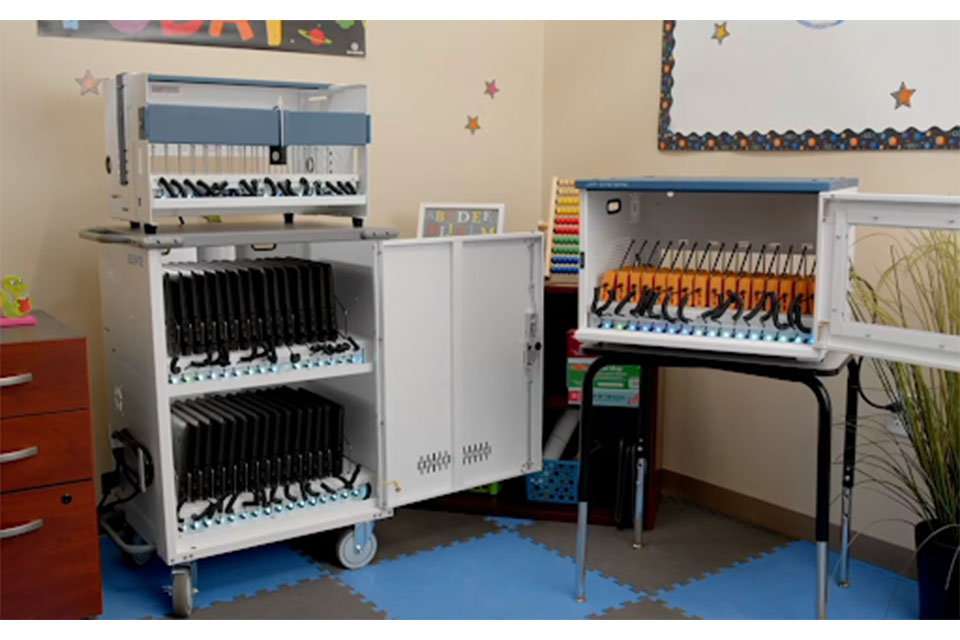How libraries, training centers, and other public spaces use Charging Cabinets
Summary
Charging cabinets, also known as charging stations or carts, are innovative solutions increasingly integrated into public spaces such as libraries, training centers, malls, airports, and transportation hubs. These units provide secure, efficient charging for multiple electronic devices, accommodating the growing dependence on technology in daily life. By enabling users to recharge their smartphones, tablets, and laptops in communal settings, charging cabinets enhance user convenience, promote longer engagement in public spaces, and support educational and professional activities.
The significance of charging cabinets is underscored by their diverse applications across various environments. In retail settings, they alleviate concerns about low battery life for shoppers, thereby improving the overall shopping experience. Transportation hubs utilize these cabinets to help travelers stay connected and informed, making long journeys more manageable. In educational institutions, libraries and schools benefit from the centralized charging solutions that support learning activities and efficient device management. Furthermore, corporate offices and public spaces like parks incorporate these cabinets to foster productivity and enhance community engagement, demonstrating their versatility and importance in modern society.
However, the implementation of charging cabinets also raises several challenges, including infrastructure limitations, maintenance costs, and accessibility concerns. For instance, the existing electrical systems in older buildings may struggle to support high-powered chargers, necessitating costly upgrades. Additionally, ensuring that charging solutions comply with accessibility standards is critical to providing equal access for all users, which can complicate deployment efforts. These factors, along with the socio-economic implications of pricing and service availability, highlight the need for careful planning and management when integrating charging cabinets into public spaces.
As technology continues to evolve, the future of charging cabinets looks promising, with increasing adoption of smart charging solutions, expansion of electric vehicle charging infrastructure, and greater accessibility efforts in underserved areas. By addressing these challenges and adapting to changing user needs, public spaces can significantly enhance the user experience and promote inclusivity, ultimately contributing to a more connected society.
Overview of Public Spaces Utilizing Charging Cabinets
Charging cabinets, also known as charging stations or carts, have become essential fixtures in various public spaces, enhancing the convenience and experience of users by providing secure and efficient charging solutions for electronic devices. These cabinets are designed to accommodate multiple devices simultaneously, featuring built-in power outlets and USB ports, making them ideal for environments with high device usage such as malls, airports, hotels, and public transport stations.
Applications in Various Public Settings
Retail Environments
In retail locations like malls and supermarkets, charging cabinets offer shoppers the ability to charge their mobile phones, tablets, and laptops. This service alleviates the frustration of low battery life, thereby improving the overall shopping experience and service quality. Shoppers can continue to browse and shop without the worry of being disconnected from their devices.
Transportation Hubs
Airports and train stations utilize charging cabinets to serve travelers who often rely on their devices for communication, entertainment, and navigation during their journeys. By providing easy access to charging solutions, these hubs ensure that passengers can stay connected and informed.
Educational Institutions
Schools and libraries benefit from charging cabinets by providing students and visitors with a centralized location to charge their electronic devices. This is particularly important in educational settings where multiple devices are in use, ensuring they remain charged and ready for learning activities. The organized and secure nature of charging cabinets helps institutions manage their technological assets more effectively.
Corporate Offices
Corporate environments have also adopted charging cabinets to cater to employees' needs. These cabinets enhance work efficiency by allowing staff to charge personal devices securely within the workplace. By ensuring that devices are always charged, companies can foster a more productive work atmosphere.
Public Spaces
In parks, squares, and other community spaces, charging cabinets serve as a valuable resource for residents and visitors alike. They provide convenient charging options while also enabling real-time monitoring for public space managers, ensuring safe usage of the devices. This feature not only enhances the user experience but also contributes to the overall safety and management of public areas.

Technology Behind Charging Cabinets
Charging cabinets, also referred to as charging stations or charging carts, are sophisticated units designed to securely store and charge multiple electronic devices simultaneously. They are equipped with various technological features aimed at enhancing efficiency and safety in device management.
Components of Charging Cabinets
Charging cabinets are typically built with multiple power outlets and USB ports, allowing users to charge a variety of devices including smartphones, tablets, and laptops at the same time. Many models include advanced features such as surge protection, cooling fans, and smart charging technology to optimize the charging process and prevent overheating.
Modular Design and Customization
One notable feature of charging cabinets is their modular design, which allows for the selection of separate modules to create various product types according to customer needs. This flexibility enables organizations to tailor charging solutions to fit their specific environments, such as libraries, corporate offices, or public spaces like malls and airports.
Real-Time Monitoring and Management
Smart charging cabinets also offer real-time monitoring and management functions. This is particularly beneficial in public places where device usage needs to be carefully monitored to ensure safety and security. Managers can track usage patterns and device status, which enhances operational efficiency and user experience.
Efficiency and Capacity Considerations
Charging cabinets generally range in capacity from ten to twenty devices, making them suitable for environments with a moderate number of users. They can effectively reduce device downtime and improve overall organizational efficiency. However, it is important to note that the capacity may not suffice for larger groups, such as an entire classroom, where more robust solutions might be required.
Enhanced Safety Features
Modern charging cabinets are designed with safety in mind, often featuring built-in safety certifications (UL, CE, FCC, etc.) and ADA compliance to ensure accessibility for all users. Additionally, many models include security features such as locking compartments to safeguard devices while they charge.

Benefits of Charging Cabinets
Charging cabinets, also referred to as charging stations or carts, offer numerous advantages that significantly enhance the user experience in libraries, training centers, and other public spaces. These benefits are crucial as society becomes increasingly reliant on electronic devices for both personal and professional tasks.
Efficient Device Management
One of the primary benefits of charging cabinets is their ability to streamline device management. These cabinets can simultaneously charge multiple devices, such as laptops, tablets, and smartphones, ensuring that they are ready for use when needed. This feature not only saves time but also reduces the likelihood of forgotten or uncharged devices, allowing for more efficient operations in educational and public environments.
Enhanced User Convenience
Charging cabinets provide users with convenient access to power sources, which can significantly improve their productivity. For instance, students and patrons can charge their devices during long study sessions or lectures without the worry of running out of battery. This easy access to power contributes to a more engaging and effective learning or working environment.
Improved Customer Satisfaction
In public spaces, the availability of charging cabinets can enhance overall customer satisfaction. By offering reliable charging solutions, businesses and institutions can differentiate themselves from competitors and show that they prioritize user needs. The convenience of having a nearby charging station encourages longer stays and increases foot traffic, ultimately benefiting revenue and engagement levels.
Cost Efficiency and Longevity of Devices
Charging cabinets not only save time but also provide cost-effective solutions for managing electronic devices. By promoting proper charging practices, these cabinets help extend the lifespan of devices, reducing the frequency of replacements. Moreover, they facilitate the efficient organization of devices, which can lower operational costs associated with device management in educational and public settings.
Space Optimization
Charging cabinets are designed to maximize space efficiency, often incorporating features that allow for compact storage while providing charging capabilities. This space optimization is particularly beneficial in libraries and training centers where floor space is often at a premium. By utilizing these cabinets, institutions can create a more organized and user-friendly environment.
Scalability and Future Readiness
With the growing reliance on technology, charging cabinets offer scalability for institutions that need to accommodate increasing numbers of devices. These solutions are adaptable to various settings, ensuring that as technology evolves, organizations can keep pace without significant additional investment.

Challenges and Considerations
While the integration of charging cabinets and stations in libraries, training centers, and other public spaces offers significant benefits, several challenges and considerations must be addressed to ensure their effective implementation and operation.
Infrastructure Limitations
One of the primary challenges in deploying charging solutions is the existing electrical infrastructure. Many locations may lack the necessary electrical capacity to support high-powered chargers, requiring expensive upgrades to the grid before installations can occur. Additionally, older buildings might face limitations with their circuit breakers, which could be overwhelmed by the increased demand from multiple charging units.
Maintenance and Operational Costs
Ongoing maintenance and repair services are essential for ensuring that charging stations remain functional and reliable. This maintenance can involve significant costs, particularly if issues such as vandalism or normal wear and tear arise. Regular monitoring services must be established to optimize performance and maintain system efficiency, which adds to the overall operational budget of these facilities.
User Accessibility and Experience
Accessibility is another critical consideration. Charging stations must be designed to meet ADA standards to accommodate users with disabilities. This includes the height of controls and ports, as well as the design of screens to ensure readability from various angles. If these considerations are not adequately addressed, the utility of charging stations can be significantly diminished for certain users.
Socio-Economic and Cultural Aspects
The pricing and billing mechanisms associated with public charging stations can also pose challenges. Libraries and other institutions must navigate socio-economic factors, ensuring that their charging solutions are accessible to all users regardless of financial status. Establishing a fair pricing policy while also managing the costs associated with providing free or subsidized services can be a complex balancing act.
Environmental Considerations
Sustainability plays a vital role in the deployment of charging stations. Integrating renewable energy sources, such as solar panels, into charging solutions can help mitigate some of the operational costs and reduce the environmental impact. However, the initial investment for such systems may be a barrier for many public spaces. Additionally, ensuring that these systems are designed for optimal energy efficiency is crucial for reducing their overall carbon footprint.
User Education and Awareness
Lastly, there is a need for user education regarding the proper use of charging stations. Users may inadvertently unplug equipment or misuse the systems if they are not adequately informed about the intended functionality of the charging cabinets. Libraries and public spaces must develop effective communication strategies to guide users in using the stations correctly and efficiently.

Case Studies
Libraries Utilizing Charging Cabinets
Libraries have begun integrating charging cabinets into their facilities to enhance user experience and accessibility. By providing patrons with the ability to charge their devices, libraries create a welcoming and functional environment that supports both academic and personal needs. For instance, some libraries have installed mobile charging stations that can accommodate multiple devices, allowing students to recharge their laptops and smartphones while studying or attending events. This not only helps keep students connected but also encourages longer visits and more productive study sessions.
Maximizing Underutilized Spaces
In efforts to optimize their physical spaces, many libraries have transformed underutilized areas, such as hallways and alcoves, into functional charging zones. By installing cabinets equipped with charging ports, these libraries not only increase storage capacity but also enhance accessibility for users who may be looking for a convenient place to charge their devices. This strategic use of space has proven beneficial, especially in smaller libraries where floor space is limited, thereby accommodating growing collections and user needs without necessitating physical expansion.
Training Centers Incorporating Charging Solutions
Training centers are also recognizing the importance of providing charging solutions. Many have integrated charging cabinets into their design to facilitate a seamless learning experience. These centers often host workshops and classes where participants rely on their electronic devices for note-taking and research. By ensuring that participants can easily recharge their devices, training centers help maintain engagement and productivity throughout sessions.
Public Spaces and Smart Infrastructure
Cities are increasingly investing in smart infrastructure to improve interactions within public spaces, including libraries and training centers. The installation of outdoor charging units in parks and civic buildings exemplifies this trend. These charging stations not only serve those visiting public spaces but also aim to bridge the gap for individuals who may lack reliable access to electricity at home. Such initiatives are essential for supporting digital access and ensuring that all community members, regardless of their housing situation, can stay connected and empowered. By embracing these innovative approaches, libraries, training centers, and public spaces can significantly enhance user experience, promote inclusivity, and support the educational and social needs of their communities.
Future Trends
Increasing Adoption of Smart Charging Solutions
As public spaces continue to evolve in response to technological advancements, the integration of smart charging cabinets is expected to gain momentum. These cabinets offer real-time monitoring and management capabilities, enhancing user experience and safety. They not only provide convenient charging services but also minimize energy waste through energy-efficient features such as smart charging technology, which stops charging once devices are fully charged. This aligns with broader sustainability goals aimed at reducing carbon footprints in urban environments.
Enhanced Accessibility in Public Spaces
Public charging solutions are likely to play a crucial role in increasing digital access, particularly in neighborhoods lacking reliable power sources. By strategically placing charging stations in accessible zones, cities can ensure that everyone, including those without stable housing, has the opportunity to power essential devices. This trend reflects a growing recognition of the importance of connectivity in modern society, where having a charged device can significantly impact individuals' ability to access job searches, health services, and emergency contacts.
Growth in EV Charging Infrastructure
With the surge in electric vehicle (EV) sales and the corresponding need for charging infrastructure, public spaces are poised to become vital locations for EV charging stations. The demand for public charging facilities is outpacing the current installation rates, prompting significant investments from both private and public sectors. Companies are increasingly forming partnerships to establish expansive networks of fast-charging hubs, reflecting a commitment to supporting the transition to electric mobility. This trend not only facilitates the growth of EV adoption but also contributes to environmental sustainability efforts.
Expansion of Charging Services in Various Settings
The future will likely see the expansion of charging cabinet services beyond traditional settings like libraries and training centers to include a diverse array of public locations such as parks, transit stops, and commercial areas. This diversification will enhance user convenience and improve overall public engagement with these spaces. Additionally, the integration of customizable options in charging solutions will allow institutions to cater to specific needs, further driving adoption and usage.
Economic Benefits and Incentives
The installation of charging cabinets in public spaces can lead to increased property values and enhanced business reputations, making these solutions attractive investments for municipalities and private entities alike. Government incentives and grants will continue to play a significant role in facilitating the installation of EV chargers, thus lowering maintenance costs and promoting sustainable development initiatives. As such, the economic models surrounding public charging solutions are likely to evolve, driven by both demand and technological advancements.
 Mobile Charging Cabinets: Power on the Go for Exhibitions and Concerts
Mobile Charging Cabinets: Power on the Go for Exhibitions and Concerts
 How Charging Cabinets Improve Attendee Experience at Conferences
How Charging Cabinets Improve Attendee Experience at Conferences
 Declutter Your Office: The Role of Charging Cabinets in Modern Workspaces
Declutter Your Office: The Role of Charging Cabinets in Modern Workspaces

